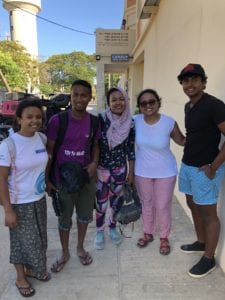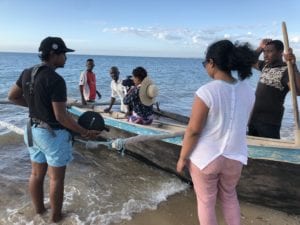Stories from locally managed marine areas
As someone who grew up on the island of Madagascar, I’m often expected to know a lot relating to the ocean—swimming, surfing, and all about seafood! However, Madagascar is the fourth biggest island in the world and the beach lies an at least ten-hour bus ride from the capital city, Antananarivo, where my family is based. Some people are surprised to hear that I did not encounter the ocean until I was 11 years old, when I traveled to the east side of the country for a family vacation. I vividly remember my aunt joking around with me on the bus ride to the coast, asking me what color the ocean was, and nearly convincing me that it was red. While I did not know much about the ocean, it always captured my imagination.
I first heard the terms “Locally Managed Marine Areas" (LMMAs) from a good friend, Vatosoa Rakotondrazafy, a Madagascar native whom I first met in New York City. At the time, she was doing research on Madagascar’s ocean governance at the United Nations and the University of British Columbia, and I was finishing up my bachelor’s degree in Pennsylvania. Following her year-long research, she returned to Madagascar and took a position as the National Coordinator of the MIHARI Network. She became the first staff member since the organization's creation in June 2012. This network advocates for small-scale fishing communities along the country’s 5,000km coastline. It links the communities together and shares sustainable fishing best practices.
MIHARI’s work is increasingly important in Madagascar, which faces a declining fish stock (small-scale fishing is the livelihood of more than 500,000 people in the country) and simultaneous degradation of the ecosystem. Fishing communities face the challenge of fishing enough to survive while ensuring the sustainability of the fish stock. The increasing frequency and intensity of climate change catastrophes, such as cyclones and droughts, exacerbates these challenges.
The fishing communities that MIHARI connects, LMMAs, are special because they are not managed by the national government. Rather, they are managed by representatives of the communities, the local government, and sometimes, members of the private sector and the NGOs. This management approach is important because grassroots communities have the best knowledge of their local environments. They are able to manage their own marine resources and use context-specific, socially acceptable solutions to address issues quickly, rather than waiting for the national government to take action a thousand kilometers away.
I’ve been lucky to witness the growth of MIHARI since 2015, when Vatosoa started coordinating the network. Her team has grown from a one-person team to a thirteen-person team, including four regional coordinators. Since then, the organization also established four regional hubs: Northwest, Southwest, Northeast, and Midwest of Madagascar. The network currently connects more than 175 LMMA community association members, as well as non-member organizations and the private sector. Please click here to visualize them. In 2017, fishers who were members of MIHARI came together for the first time to present three motions to the Ministry of Fisheries. These motions elevated the island’s small-scale fishers’ priorities, which included the demand for the creation of reserved areas for small-scale fisheries, in order to resolve their conflicts with industrial fisheries. These achievements led Vatosoa to win the 2019 Whitley Award, in recognition of her role as an ambassador and advocate for these communities.
I will confess that it was not until I heard Vatosoa’s Whitley award acceptance speech that I grew curious about the LMMAs. She dedicated the award to all the small-scale fishers of Madagascar and called them “the guardians of our seas”. After hearing her speech, I grew self-conscious: I had subconsciously ignored the challenges faced by those responsible for my favorite dish, coconut shrimp, among other delicacies. I wanted to learn more about these unsung heroes, their faces, their stories, and their challenges. In private conversation about these individuals to the MIHARI staff, they gave me examples of the various sacrifices they have made in order to feed an entire nation. These sacrifices included initiating temporary fishing closures and abstaining from fishing a certain species for a given period, which could mean not eating in order to ensure the sustainability of the fish stocks for future generations. When the organization told me that I could write blogs to raise the visibility of these fishing communities and the MIHARI network, I immediately jumped right in.
In December of 2019, I met up with my friend Nebiat Assefa Melles, a documentary filmmaker whom I met at UC Berkeley, her sound assistant and videographer based in Toliara, Faniry Njava, and two representatives from MIHARI, Prisca Ratsimbazafy and Herizo Emmanuel. We traveled to the South of Madagascar, the land of the Vezo, a group of semi-nomadic people of the ocean whose name comes from the Malagasy verb “voizo,” to row. We visited two LMMAs close to the city of Toliara, one of them called TAMIA and the other called FIMIHARA. I sat down with some of the community members and leaders to listen to their stories and understand their day-to-day experiences.
On the photo on the far left, from left to right, Prisca Ratsimbazafy , Herizo Emmanuel, Nebiat Assefa Melles , Rebeka Ramangamihanta and Faniry Njava.


